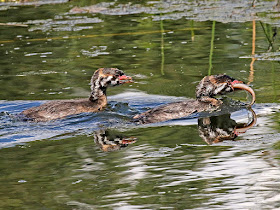I
have been following the Pied-billed Grebes at Magnuson Park in Seattle for
about two months now, and they never fail to be interesting and always offer
good photo ops. Various members of the family often rest among the lily pads;
presumably they are expending most of their energy digesting a good meal.
The
adults continue to feed their young Oriental weatherfish (Misgurnus anguillicaudatus), a loach from Asia that has invaded the
pond from Lake Washington, where it was unintentionally introduced. We have now
found four species of fish in the pond, including Prickly Sculpin (Cottus asper), Pumpkinseed (Lepomis gibbosus) and Largemouth Bass (Micropterus salmoides). The first is a
native species, the other two introduced long ago throughout the region for sport
fishing. I still don't have any idea how they got into the pond.
Anyway,
there must be a lot more loaches, or they are easier to capture, as again and
again that's what I see the adult grebe feeding to the young. In this case, one
young got the fish and another followed it around and around for a while. It
was obvious the lucky young was trying to swallow it but was having a hard time
because it couldn't slow down. But finally it managed to gulp it down.
 The
adults feed to the young anything than can catch, here a dragonfly, an adult male Common
Green Darner (Anax junius) that
perhaps was captured when it was mated with an egg-laying female at the water
surface. I doubt if a grebe could pluck one out of the air.
The
adults feed to the young anything than can catch, here a dragonfly, an adult male Common
Green Darner (Anax junius) that
perhaps was captured when it was mated with an egg-laying female at the water
surface. I doubt if a grebe could pluck one out of the air.
Another one is about to swallow the larva of a California Spreadwing (Archilestes californicus), a large damselfly
that is common in the pond.
There
are no more ducklings for the male grebe to savage, and it seems to be getting
along with the single American Coot that now lives in the pond. Maybe this is
the stage in nesting when that fierce aggression is relaxed. But I've seen the
male chase its own young violently on several occasions in exactly the same
way, rushing it from underwater, not sure what that is all about. I still
haven't been able to get a photo of it, as it happens very quickly and only once.
Maybe it's just "I've had enough of all that begging."
Grebes
swim amazingly rapidly underwater, and here you can see the size of the foot that,
together with its mate on the other side, propels them like that. The long toes are lobed rather than webbed as they are in a duck, and both adaptations seem to work equally well.
Dennis Paulson









